What’s the first Vietnamese food that pops to mind for you? Phở? Bánh mì? Spring rolls? All of these are quintessential dishes to be sure—and you’ve already knocked off three of the 20 in this list—but we’ve only just begun.
When you’re talking about “Vietnamese food,” as mentioned before, you’re talking about rice in many forms (steamed, sticky, noodles, pancakes, porridge), fish sauce (lots of it), herbs (mint, cilantro, lemongrass), seafood, pork, beef, chicken, and tropical fruits (rambutan, banana, papaya, mango, etc.), with borrowed flavors from the French imperialists and nearby countries like Laos, Cambodia, Thailand, and China.
Most dishes fall under broader categories. “Bánh,” for example, encompasses the many steamed rice cakes and rolls (like bánh cuốn and bánh bèo); not to be confused with the “bún” family, which always involves some rice vermicelli (whether with pork, as in bún chả, or the various noodle soups, such as bún rieu); “goi” is synonymous with salad, and in Vietnam they’re typically made with non-lettuce things like unripe green papaya or mango….
By no means is this a definitive list—just 20 of the most memorable, most interesting, and most delicious dishes in my experience. Many of them vary by region. For example, the phở of the north is defined by a clear broth whereas the southern-style phở in Saigon might be murkier with more sauces, herbs, and other add-ins.
Speaking of sauces, let’s pause for a second to honor nước chấm, which is on virtually every table, at every meal, every single day. The amalgam of fish sauce, lime juice, chili, garlic, and sugar is salty, tangy, spicy, fishy, sweet and exactly what you want for dunking, dipping, or just plain drinking (oh, is that just me?). It’s mentioned many times in this roundup.
What’s your favorite Vietnamese dish?
Author’s note: I traveled to Vietnam with Intrepid Travel, a company that organizes trips all over the world. They recently launched special food-themed journeys (both long and shorter day trips) to many destinations, including Vietnam…
Bánh cuốn
The bánh family includes a number of steamed rice cake-like dishes. So soft and delicate, my favorite was this bánh cuốn straight from the steamer. Our Intrepid Travel guide took us to a third-generation bánh cuốn master in Hanoi who mesmerized us with her skills. She ladled each scoop of the rice flour-based batter onto the steamer, covering it with a lid for a matter of seconds, then carefully transferred the gossamer-thin sheets with a bamboo stick onto a tray to be filled with minced mushrooms and pork. Each bite is topped with deep-fried shallot bits and must be dipped into that nước chấm sauce.
Also in the bánh family: bánh bèo (literally “water fern cake”) from the old imperial city of Hue in central Vietnam. It’s topped with chopped shrimp, scallions, mung bean paste, crispy fried shallots, and fish sauce.
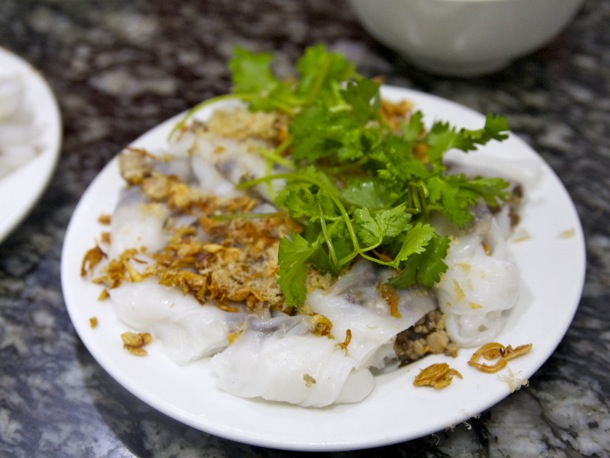
Phở
Phở is just one of many, many, MANY noodle soups in Vietnam. From a strictly linguistic standpoint, phở refers to the rice noodles, not the soup itself. But it’s become synonymous with the staple soup served with various meat parts (usually beef or chicken), bean sprouts, lime wedges, the essential greens (basil, mint, cilantro, and onions), and whatever chili sauce and fish sauce you need to doctor up the broth to your liking. It’s cheap, tasty, and especially popular for breakfast in Hanoi. We visited a popular phở joint that usually sells out by noon.
The northern-style phở in Hanoi is typically defined by a clear broth whereas the southern-style broth tends to be slightly sweeter, murkier from added sauces, and popping with more herbs and other garnishes.
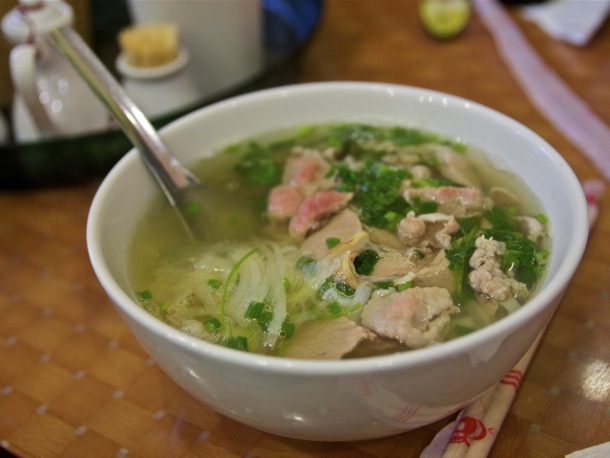
Bún chả
Rice vermicelli (“bún”) is a staple all over Vietnam. My first night in Hanoi, this one in particular was a must-order. Bún chả. You really can’t go to Hanoi without trying bún chả. It comes with grilled pork sausage patties, a basket of herbs, bean sprouts, pickled veggies, and, once again, the ever-important nước chấm sauce (pour it over everything).
A note on bún: Vermicelli is found in many noodle soups too like bún rieu, a tomato broth soup with crab and bún bò Huế (pronounced “boon ba hway”) with beef (bò). There are many, many bún dishes that didn’t make this list but are nonetheless popular and delicious.
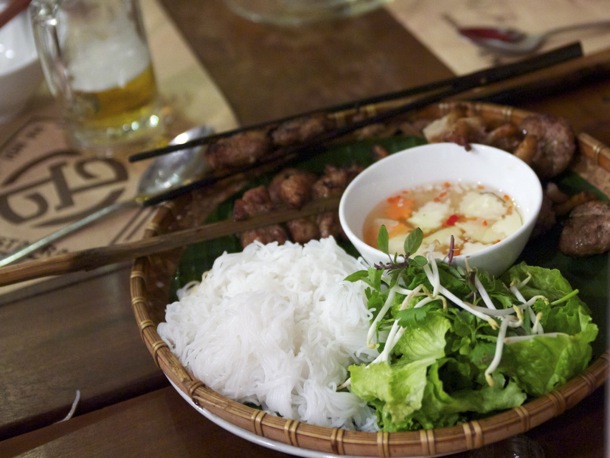
Gỏi cuốn (Spring Rolls)
Gỏi cuốn literally means “salad rolls” and should be distinguished from the fried rolls, which are also sometimes called spring rolls (or chả giò). The translucent cigar-shaped rolls are packed with greens, sometimes shrimp and/or pork, and herbs. They need a dunk in nước chấm of course. Almost every region in Vietnam has its own distinct spring roll but no matter where you are, the wrapping and rolling process is more or less the same.
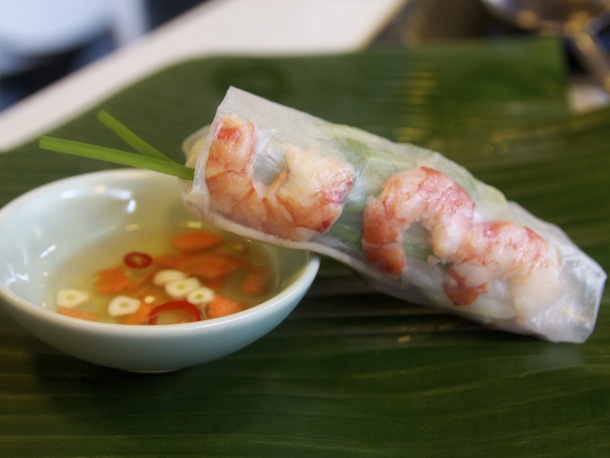
Bánh mì
Ah, yes. The bánh mì can be found all over the world at this point. But the creation story harkens back to French colonialism, when the imperial forces in Vietnam brought with them their crusty baguettes. Since then the Vietnamese have made this sandwich entirely their own with fillings like pork belly, fish cakes, meatballs, and the very necessary pickled carrots, daikon, and not-messing-around chilies. Do NOT wipe your eyes after eating one of these. Those chilies will melt off your eyeballs.
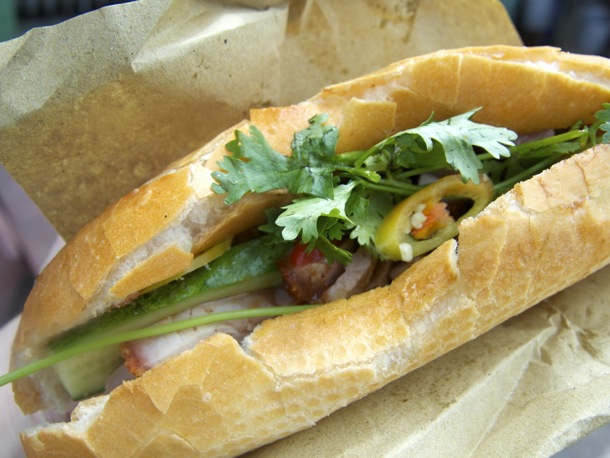
Ca Kho To (Caramelized Fish in Clay Pot)
Clay pots are kind of like the Asian cousin of the Dutch oven. The thick clay walls retain heat and moisture, helping to soften and caramelize meats when braised. In this dish, the fish develops a sweet-savory gooeyness from the sugar and fish sauce over the course of the long braise. “This reminds me of my grandma,” said my Vietnamese friend who grew up eating this classic comfort food.
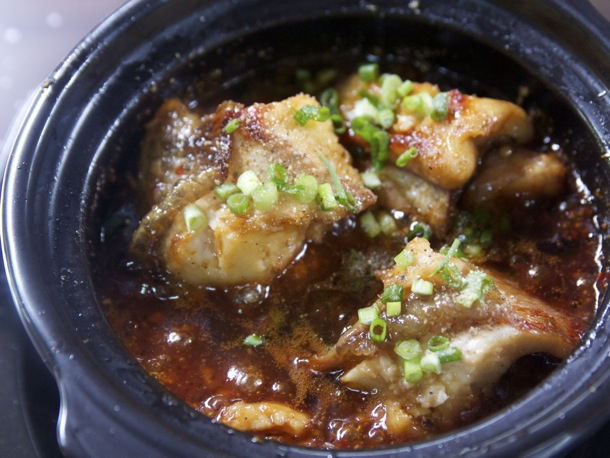
Bánh xèo
Sorry to play favorites but bánh xèo (pronounced “boon say-oh”), you are my favorite. It means “sizzling pancake,” and it’s just that. The savory, crisp-edged, crepe-like pancake is best enjoyed straight from the pan. The batter is made with rice flour, coconut milk, and turmeric (hence the nice golden-yellow hue) and is pan-fried altogether with pork, shrimp, and a heap of bean sprouts. Wrap up the pancake with lettuce and herbs. I’ll never forget stuffing my face with these on tiny plastic stools at Bale Well in Hoi An.
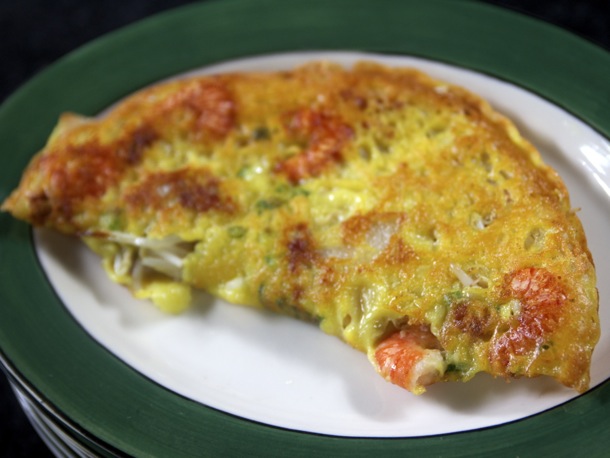
Canh (Vietnamese Soups)
The soup category is vast; too vast to cover thoroughly here. But one important subcategory is the sour soups, or “canh chua,” of the south, usually made with starfruit, tamarind, pineapple, and/or tomatoes. They are full of contrasting flavors (sour, sweet, and savory) and contrasting textures (various veggies and seafood).
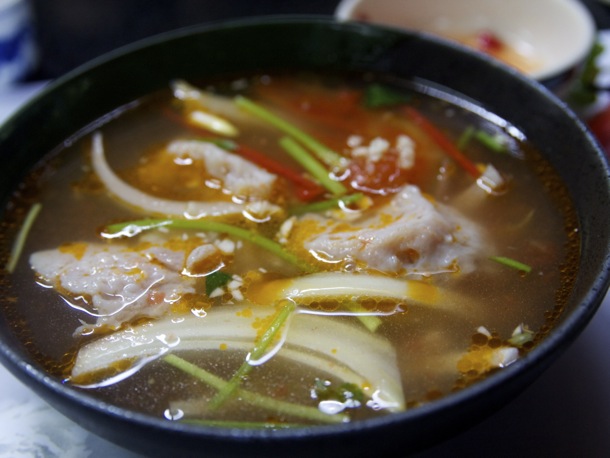
Banh Cam / Banh Ran
From what I’ve been told, banh cam and banh ran are nearly identical to one another, minus some nuanced regional differences. Crisp on the outside and chewy inside, these golden-fried glutinous balls are speckled with sesame seeds and filled with a sweet mung bean paste. One of the most beloved Vietnamese desserts and for obvious reason. I mean, they are deep-fried balls of sweet mung bean-filled joy.
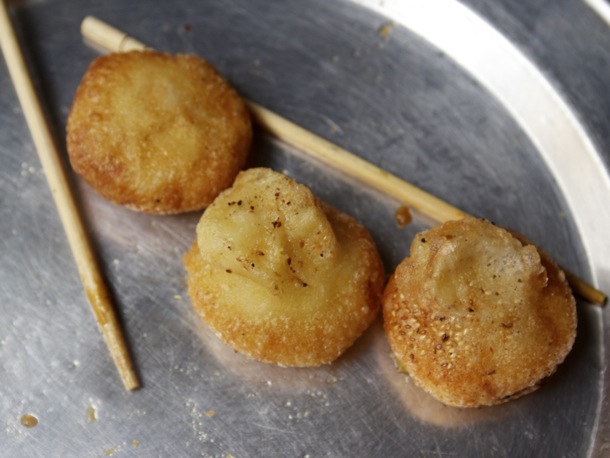
Banh Chung / Banh Tet
These banana leaf-wrapped parcels are eaten during the lunar new year celebration of Tet, which is a very big deal in Vietnam (and coming up soon in February!). People buy new clothes, paint their homes, clean everything, and cook for days in preparation of the mega-feast. Many of these sticky rice cakes—known as Banh Tet during the holiday—are prepared ahead of time, both to be eaten and to be placed before ancestral altars. The glutinous rice bundle is tightly packed with fatty pork and mung bean.
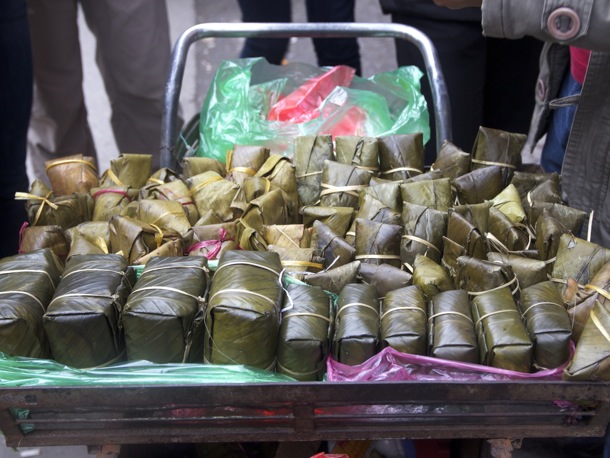
Goi (Vietnamese Salads)
Goi is a generic term for “salad” in Vietnam but doesn’t usually involve any lettuce. The base instead can be a pile of thinly sliced green papaya or mango, lotus root, cabbage or pomelo. Here’s one we made in Hanoi with sliced banana flowers (thick, purple, crunchy) and pickled carrots, cilantro, crushed peanuts, and, once again, the very necessary nước chấm sauce.
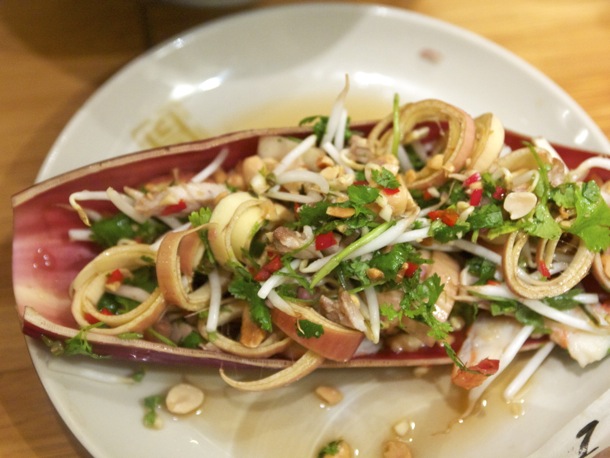
Cháo
Vietnam’s rice porridge is thick, creamy, hearty and should be able to cure whatever ails you—primarily a cold and hangovers. Top it with slices of chicken, beef, pork, fish, or in this case, pig parts (mostly liver and tubular innards). This is a bowl of Cháo Lòng from Saigon where street vendors can be easily spotted with their giant metal vats of porridge, piles of offal, and stacks of golden fried dough. Scallions and black pepper are scattered on top and at the table you’ll get a platter of bean sprouts, lime wedges, ginger and fish sauce to season the porridge to taste.
[Photograph: Cathy Danh]
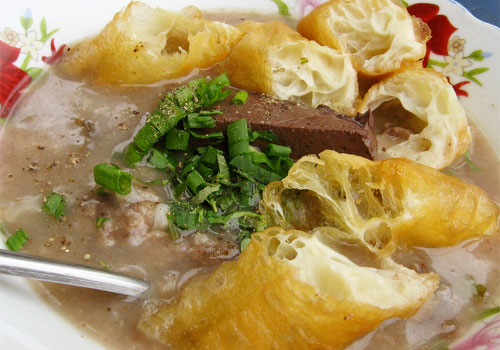
Cơm tấm (“Broken Rice”)
When Vietnamese rice farmers couldn’t sell their broken grains, which broke sometimes while being processed from the field, they had to eat the poor rejected grains themselves. This cheaper alternative to “unbroken” rice has actually become popular over the years as some people like its softer texture. You’ll find it on menus with a variety of toppings; here it comes buried with pork skin, grilled pork chop, pork loaf, and an egg.
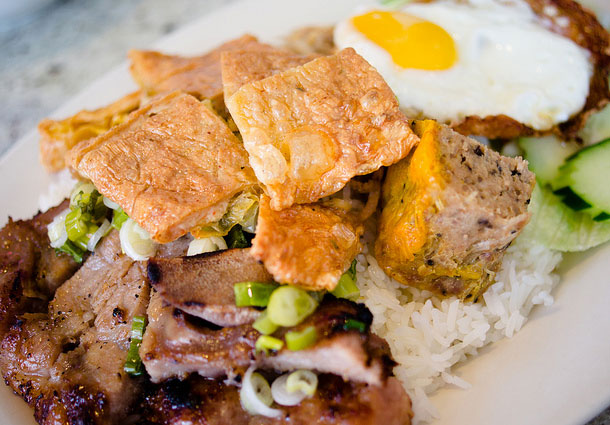
Rau muong
Otherwise known as water spinach or morning glory, this is a staple veggie in Vietnam. If Vietnam declared a national vegetable, it’d probably be this. You’ll find the greens stir-fried with copious amounts of garlic or floating in a noodle soup.
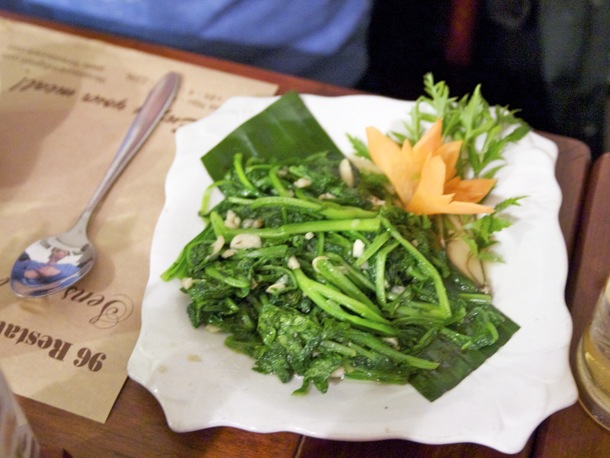
Cha Ca Hanoi
Cooking with dill is a uniquely northern Vietnamese thing. I didn’t see (any?) dill once we traveled south from Hanoi. But in this special Hanoi dish, flaky white fish is marinated in turmeric and galangal and served with generous amounts of dill. Dill is treated more like a vegetable than a garnish here.
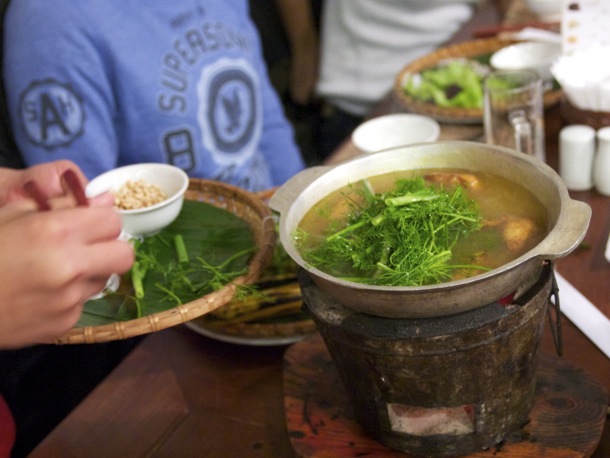
Chè
Chè refers to any sweet pudding or dessert soup, which usually gets covered in jellied or dried fruit toppings. Taste the rainbow of longans, rambutan, mangoes, jackfruit chips, mung beans, black beans, and more sticky sweetness.
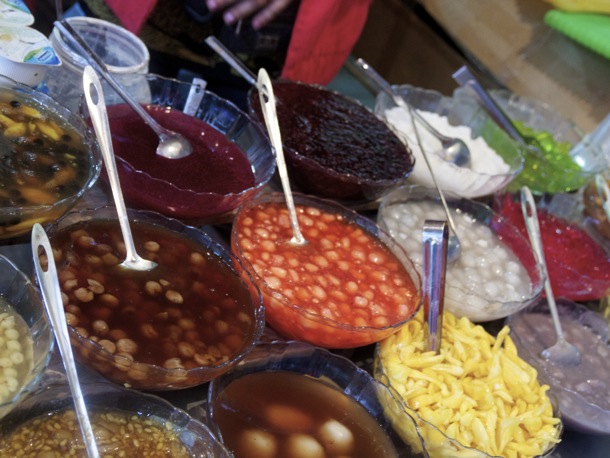
Cao lầu
This is not something you’ll find all over Vietnam—it’s very unique to Hoi An, the historic trading port town along the central coast. The most important element of this pork and noodle dish is the noodles. They’re made with water drawn from one specific well: the thousand-year-old Ba Le well in Hoi An. (What if they were made with water from a different well?! Let’s not even entertain that thought.) The noodles are pre-soaked in the magical well water along with lye made from wood ash brought from the Cham Islands outside of Hoi An—told you these were special noodles! They end up having a special chewiness and are served in some, but not much, broth with thinly sliced pork, herbs, bean sprouts, and crisp crouton-like squares of fried dough.
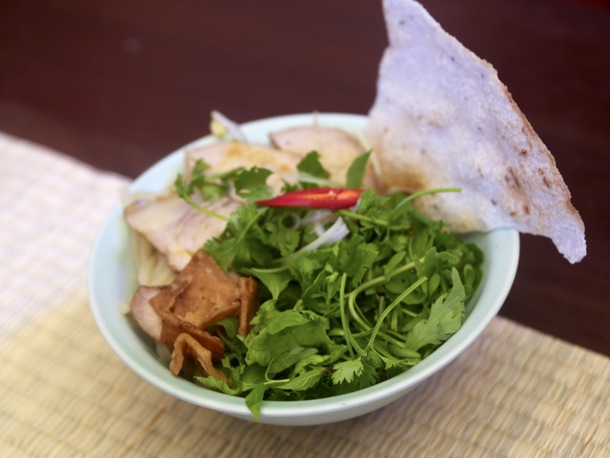
Hot Vit Lon (Fetal Duck Eggs)
“Can I have one without a formed beak and face please?” That was an actual question I uttered to myself when our guide Hanh was scooping out bites. This is not for the squeamish. Like balut in the Philippines, the fertilized duck embryo is matured for a few weeks then boiled. Tap the shell and inside you’ll see the itty bitty creature’s proto beak and webbed feet. Spoon up the baby bits (eeeeek) with pickled garlic, and I’m going to stop right there.
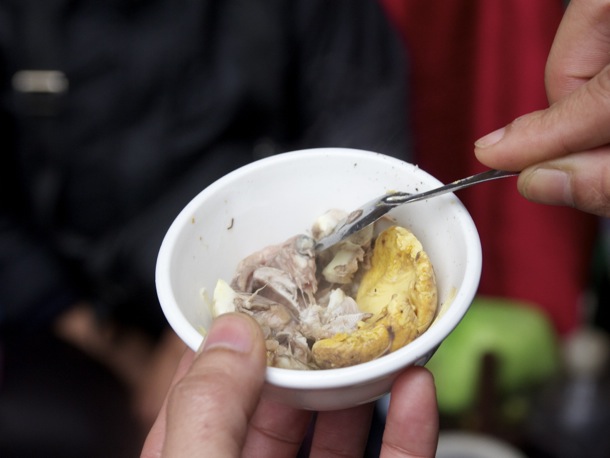
Ca Phe (Coffee!)
Not a dish per se but sometimes feels more dessert than drink with all that glorious sweetened condensed milk. I’ll get into this more over on Serious Drinks soon, but what you’re looking at here is a special “egg coffee” from Hanoi. That foam perched on top of the dense, dark coffee is sweetened condensed milk mixed up with a raw egg. Mhmm.
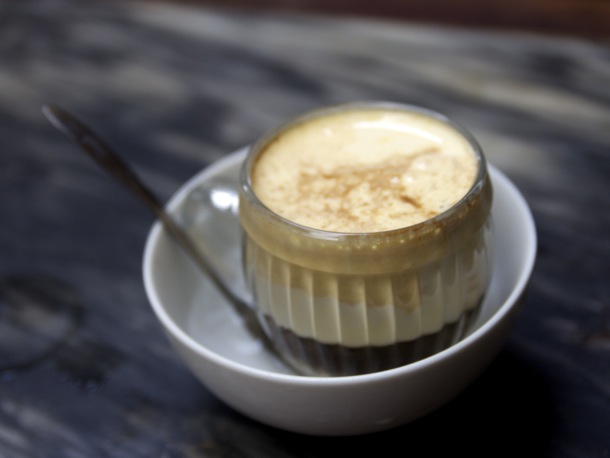
Nước chắm
Not a dish, but it’s what accompanies just about every dish—this is the dipping sauce I keep mentioning. Sweet, spicy, sour, and fishy, it comes in a little bowl on practically every table, with every dish, every single day. I wouldn’t be surprised if I had consumed a few liters of nước chắm over the course of a week in Vietnam. It’s made with fish sauce (obviously), lime juice, sugar, garlic, chili peppers, and sometimes shredded carrot or lemongrass.
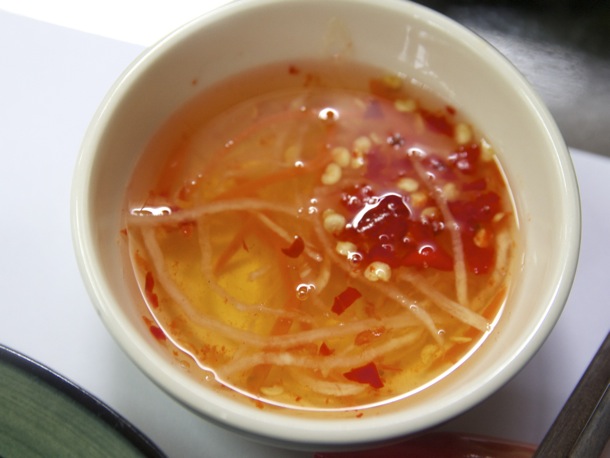
Vietnam Embassy Singapore





















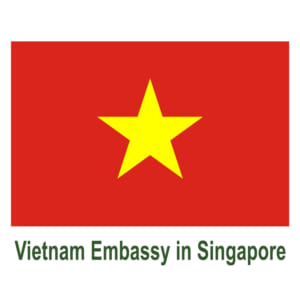

![[New] Major changes in Vietnam Immigration Policy since July 1, 2020](https://vietnamembassy-singapore.org/wp-content/uploads/2020/06/new-major-changes-in-vietnam-immigration-policy-since-july-1-2020-120x90.jpg)

